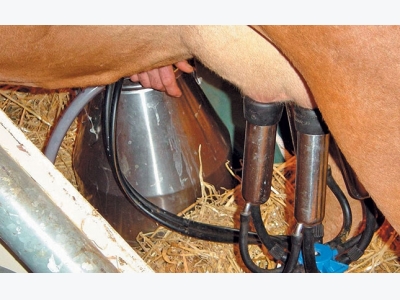Dairy cows: healthy animals, healthy profits

The health of dairy cows is directly related to their conception rates and milk production.
Milking machines are used to harvest milk from cows when manual milking becomes inefficient or labour-intensive. Photo: David Monniaux
Animals should be treated according to the internationally recognised Five Freedoms for animals under human control. Originally defined by the UK government in 1965, these are:
Originally defined by the UK government in 1965, these are:
- Freedom from thirst, hunger and malnutrition;
- Freedom from discomfort;
- Freedom from pain, injury or disease;
- Freedom to express normal behaviour;
- Freedom from fear and distress.
In addition, the Food and Agriculture Organisation of the United Nations makes several recommendations for the health of dairy herds:
- Choose breeds well suited to the local environment and source animals with known disease status;
- Vaccinate all cows, and administer medicines according to directions;
- Supply antibiotics when needed and not as a preventative measure;
- Do not feed growth hormones;
- Store chemicals and veterinary medicines securely and dispose of them responsibly.
Optimal feeding for a dairy herd
Feed should be given in sufficient quantity. It should also be clean and appropriate for the breed and the animals’ stage of development; this will contribute to the production of good quality milk.
Ensure that feed is safe by storing it properly to avoid contamination, and using chemicals responsibly on pastures and forage crops. Observe a grazing withholding period to prevent exposure to fertilisers and pesticides.
Check drinking water regularly to ensure that it is clean and safe.
It is a good idea to implement sustainable practices when growing feed by managing the flow of nutrients on your farm, such as using effluent responsibly to grow feed. This will be discussed at a later stage.
A comfortable, well-maintained shelter
Cows need protection against extreme weather. The shelter should provide adequate space for them to sleep in, and should be cleaned and re-bedded regularly.
It should have adequate light and airflow; both are important for animal well-being and hygiene. Natural sunlight is the best sanitiser!
The floors in the shelter and transfer areas should be level to avoid foot and leg damage: a regularly maintained, dry earthen floor is ideal. The floors of the holding and milking sheds should have a gentle slope for urine drainage and manure removal.
Milk lactating cows regularly to ensure they are free of pain. Milking frequency will vary from farm to farm depending on the stage of the animal and the equipment used to milk, but traditionally cows are milked at least twice a day.
If you milk three or more times a day, provide additional feed.
Good milking practices will help keep the animals and their milk free of disease and contaminants. Employees should follow the required hygiene rules and clean and disinfect milking equipment regularly.
Wash down the milking shed and remove manure as soon as the cows have been milked and leave the shed.
Laws and guidelines
See Government Notice No. 34198 of 15 April 2012 for clear guidelines on milking shed health regulations. Other South African legislation regarding animal welfare can be obtained atwww.gov.za.
Slaughtering of bull calves at birth is not condoned. Look after male calves properly and sell them to reputable buyers.
Có thể bạn quan tâm
 Enzootic bovine leucosis: Dairy’s cancer time bomb
Enzootic bovine leucosis: Dairy’s cancer time bomb Enzootic bovine leukosis currently represents one of the largest threats to SA’s dairy industry. If nothing is done to prevent and control new infections
 The way forward with grass-fed beef
The way forward with grass-fed beef Cloete Afrikaners produces and supplies beef directly from the veld. This approach is the only way to ensure that the family farms for another 150 years
 Environmental benefits of Afrikaner cow productivity
Environmental benefits of Afrikaner cow productivity Cow productivity in beef cattle is measured as kilogram calf weaned per mature livestock unit (MLU) mated